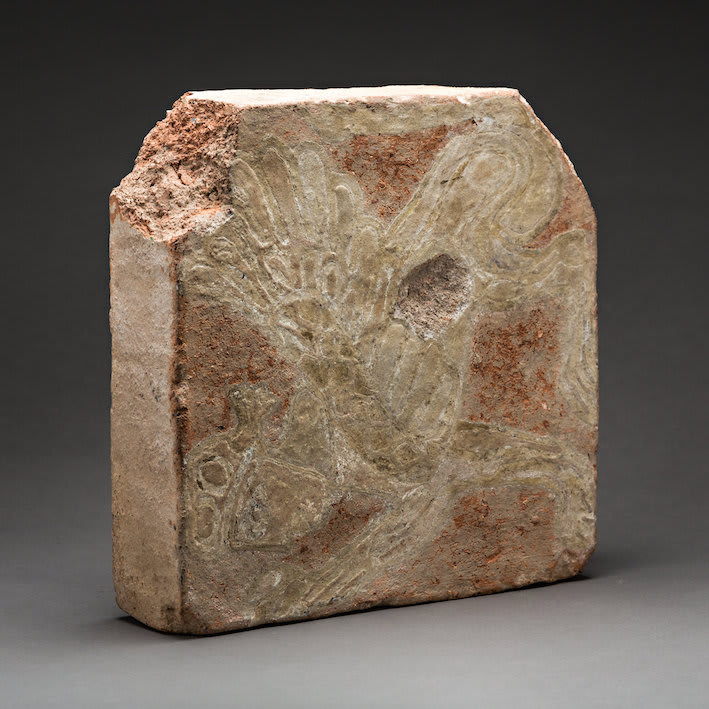Painted Tile with Mythical Creature, 900 BCE - 600 BCE
Stone
34.5 x 34.9 cm
13 5/8 x 13 3/4 in
13 5/8 x 13 3/4 in
SF.320
The tradition of painted stone tiles as adornment began in 13th century B.C southern Iran. Throughout the past, great civilizations decorated their constructions with sumptuous paintings and tiles. Many remarkable...
The tradition of painted stone tiles as adornment began in 13th century B.C southern Iran. Throughout the past, great civilizations decorated their constructions with sumptuous paintings and tiles. Many remarkable examples survive today from the wall paintings and mosaics of Pompeii to the glazed tiles of the Ishtar Gate in Babylon. This Assyrian tile would have most likely adorned the walls of a temple or palace structure. The painted image depicts a Sphinx, a mythological creature with a head of a woman, the body of a lioness, the wings of an eagle, and a serpent-headed tail. The word sphinx comes from the Greek Σφίγξ, apparently from the verb σφίγγω (sphíngō), meaning ‘to squeeze’, ‘to tighten up’. In ancient Greek culture, the first sphinxes appeared in sculpture from 7th century BCE.
Although archaeological excavations reveal the land of the Assyrians had been inhabited as early as 5000 B.C., it was not until the reign of King Sargon of Akkad in 2371 B.C. that the Assyrians first rose to glory. Under Sargon, the kingdom rapidly expanded north to the city of Ashur and as far west as the Mediterranean, controlled by a central government based in Akkad. By 1813 B.C., King Shamshi-Adad I united the cities of Ashur, Nineveh, and Arbel into one cohesive administrative unit. These three cities, as well as Arrapkha and Kalhu (later known as Nimrud), form the historical core of the Assyrian Kingdom remained a credible force throughout the Mediterranean world for the next millennium. While various parts of Assyrian territory were annexed for brief periods by neighbouring civilizations, this core remained firmly intact. The Assyrians experienced another Golden Age, lasting from the 9th until the 7th Century B.C. (this period is referred to as ‘Neo- Assyrian’). During this period, the kingdom grew to its largest extent, encompassing the lands from parts of modern Iran to the Mediterranean, from Anatolia to Egypt. However, it proved difficult even for the powerful Assyrian monarchs to maintain control over this vast territory for very long. By the end of the 7th Century, the Assyrian Kingdom began to collapse under the weight of assaults from the Babylonians to the south and the newly founded Medes Kingdom to the east. In 612 B.C., Nimrud burned for the second time in three years, followed by the sacking of Ashur and Nineveh, effectively ending Assyrian control of the ancient Near East.
Although archaeological excavations reveal the land of the Assyrians had been inhabited as early as 5000 B.C., it was not until the reign of King Sargon of Akkad in 2371 B.C. that the Assyrians first rose to glory. Under Sargon, the kingdom rapidly expanded north to the city of Ashur and as far west as the Mediterranean, controlled by a central government based in Akkad. By 1813 B.C., King Shamshi-Adad I united the cities of Ashur, Nineveh, and Arbel into one cohesive administrative unit. These three cities, as well as Arrapkha and Kalhu (later known as Nimrud), form the historical core of the Assyrian Kingdom remained a credible force throughout the Mediterranean world for the next millennium. While various parts of Assyrian territory were annexed for brief periods by neighbouring civilizations, this core remained firmly intact. The Assyrians experienced another Golden Age, lasting from the 9th until the 7th Century B.C. (this period is referred to as ‘Neo- Assyrian’). During this period, the kingdom grew to its largest extent, encompassing the lands from parts of modern Iran to the Mediterranean, from Anatolia to Egypt. However, it proved difficult even for the powerful Assyrian monarchs to maintain control over this vast territory for very long. By the end of the 7th Century, the Assyrian Kingdom began to collapse under the weight of assaults from the Babylonians to the south and the newly founded Medes Kingdom to the east. In 612 B.C., Nimrud burned for the second time in three years, followed by the sacking of Ashur and Nineveh, effectively ending Assyrian control of the ancient Near East.



